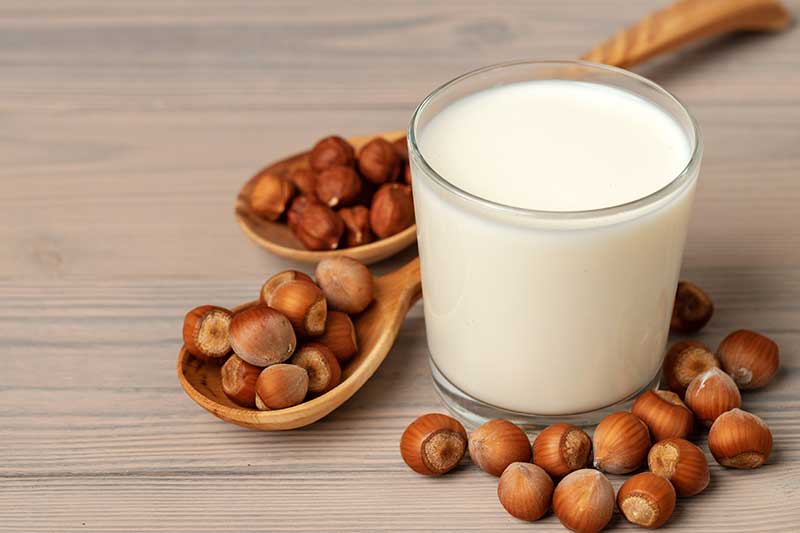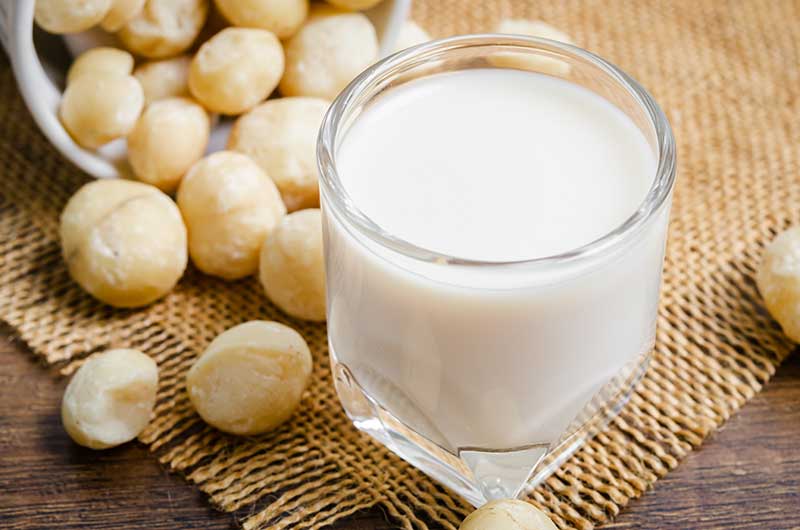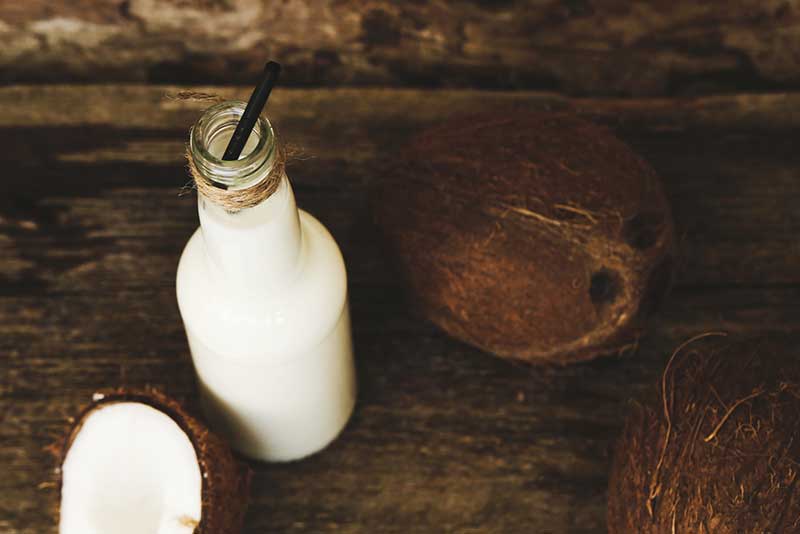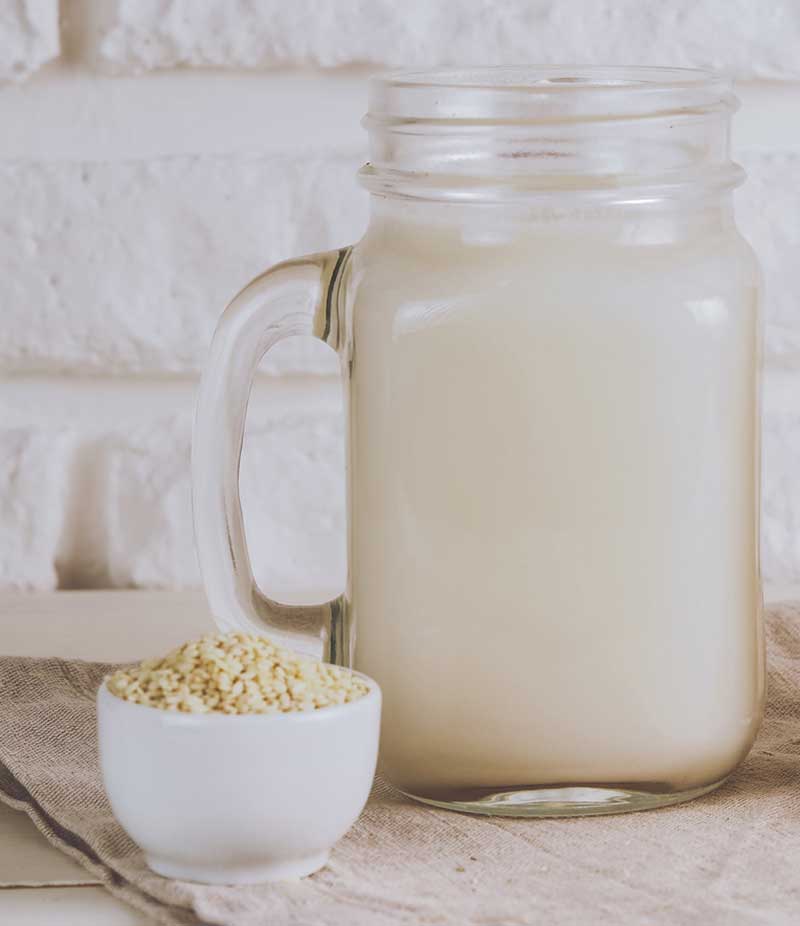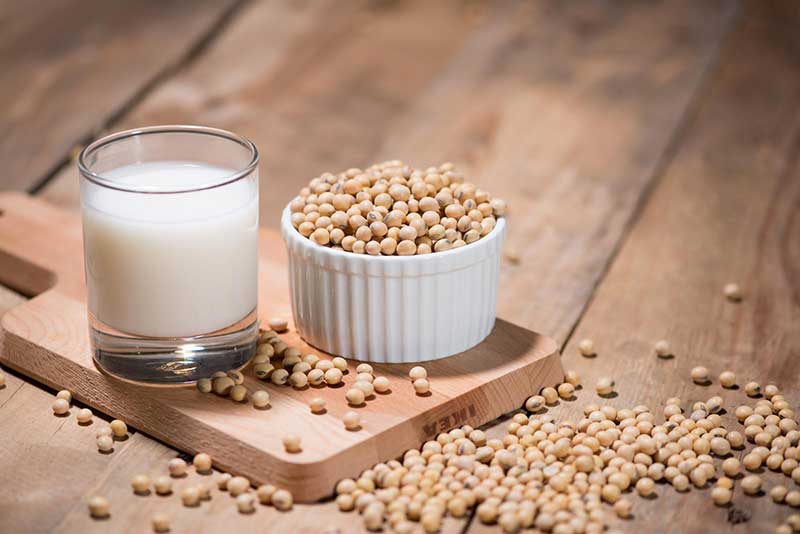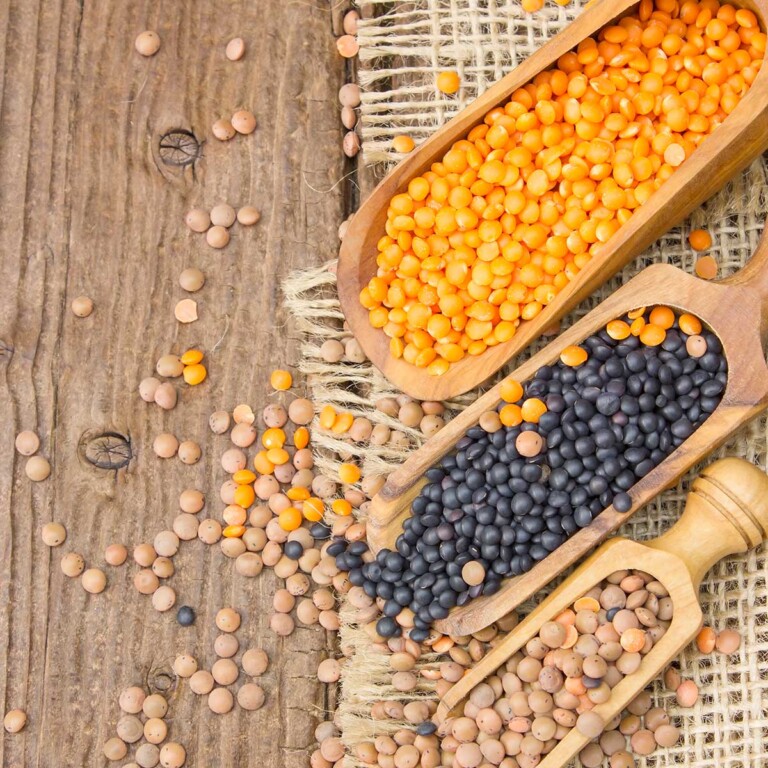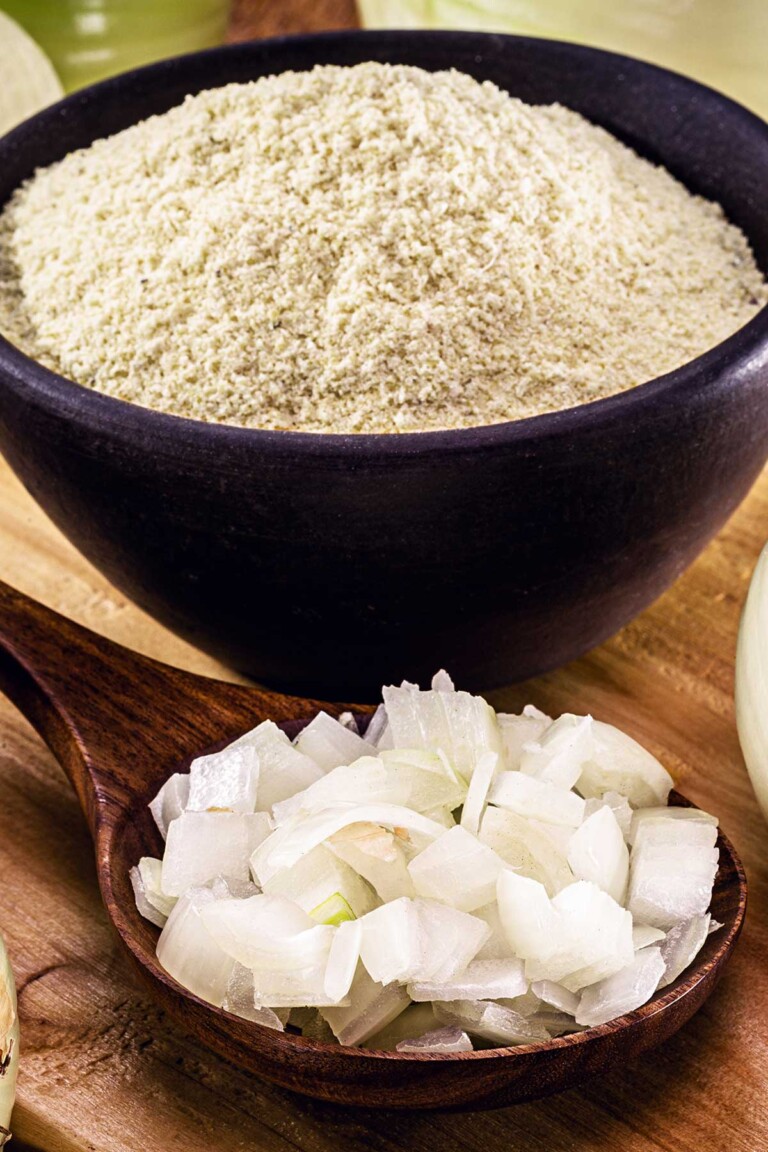The Ultimate Guide to Plant Based Milk + How to Make It
This post may contain affiliate links. If you make purchase after clicking a link, I may receive a commission at no extra cost to you.
Last Updated on September 14, 2023
Whether you are lactose intolerant, on a plant-based diet, or just looking for alternatives to dairy milk, there are many plant based milk options available to choose from. We’ll cover all the various options for vegan milk that’s plant based, and even tell you how to make them from home.
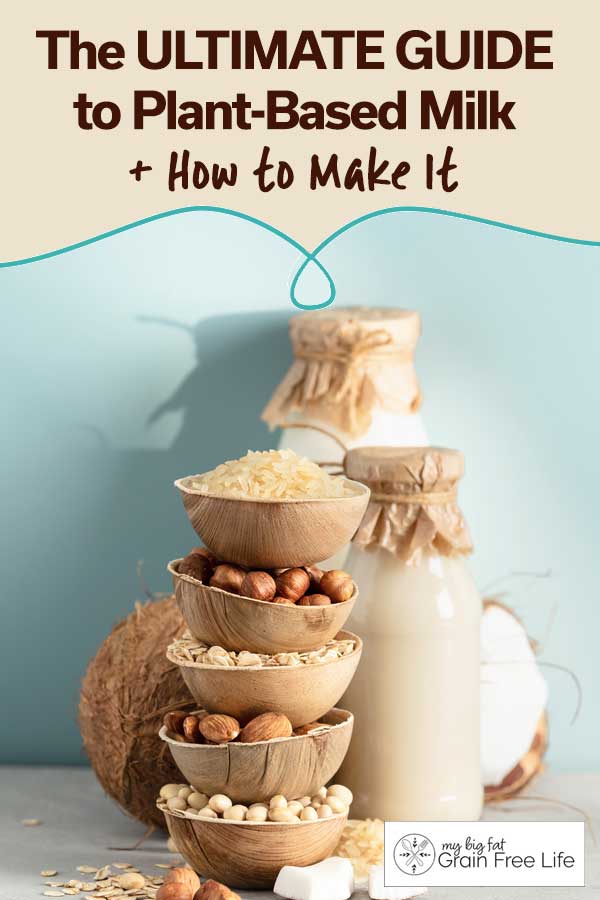
Plant Based Milk
If you are looking for dairy milk alternatives, plant milks are a good place to start. There are many alternative milks to standard dairy milk available, and you can easily make them from home.
We’ll explore the various types of plant-based alternatives, including nut milks, seed milks, grain milks, legume milks, and even some fruit and vegetable milks! An easy plant based milk recipe for each style is included so you can make it from scratch.
How to Choose a Healthy Plant-based Milk
It’s easy to find a plethora of non-dairy alternatives for real milk at the grocery store, but how do you know which ones are the best to buy?
It’s important to carefully read all the ingredients. The best plant based milks will include very few main ingredients, such as nuts and filtered water. Added vitamins aren’t bad, but you should watch for additives like oils, sugar, salt, carrageenan, gums, and other preservatives that can make it not-so-healthy for you.
Plant-Based Milk Alternatives
We’ll go over the following plant-based milk products and take a look at the way each is made and the nutrition label. You’ll even learn how to make the plant-based beverages yourself!
They’re all dairy free, lactose free, and vegan, but some of the non-dairy milk alternatives are made with nuts, so if you have a tree nut allergy, you’d obviously want to avoid those. The good news is, there are also nut-free plant milk options.
Nut Milks
- Almond Milk
- Cashew Milk
- Pistachio Milk
- Hazelnut Milk
- Walnut Milk
- Macadamia Nut Milk
- Coconut Milk
Seed & Legume Milks
- Peanut Milk (peanuts are not actually nuts, rather a type of legume)
- Hemp Milk
- Sunflower Seed Milk
- Sesame Seed Milk
- Flax Milk
- Pumpkin Seed Milk
- Soy Milk
- Pea Milk
Fruit, Vegetable, & Tuber Milks
- Potato Milk
- Banana Milk
- Tigernut Milk
Grain-based Milks
- Oat Milk
- Rice Milk
Making Plant-based Milk Homemade
Some supplies you will need to make your own non-dairy milk from home:
- high speed blender
- nut milk bag or cheesecloth
- sterile glass jars with airtight lids
If you make a lot of plant-based milk, you might find the Almond Cow to be a worthwhile purchase. I use it to make nut milks, and it’s so much easier than using mesh nut milk bags!
Keep reading to learn about all the various plant based milk options for you to try. We’ve included easy recipes so you can make them yourself if you choose.
Plant Based Milk
Let’s take a look at all the different types of plant-based milk you can choose from.
You might also want to check out our comparison on hemp milk vs almond milk.
Plant Based Milk: Nuts
Nut milks are the most popular type of plant based milk available. Most nuts can be made into milk by blending the nuts with filtered water. You can optionally add a touch of natural sweetness to it using a healthier sweetener like raw honey or pure maple syrup.
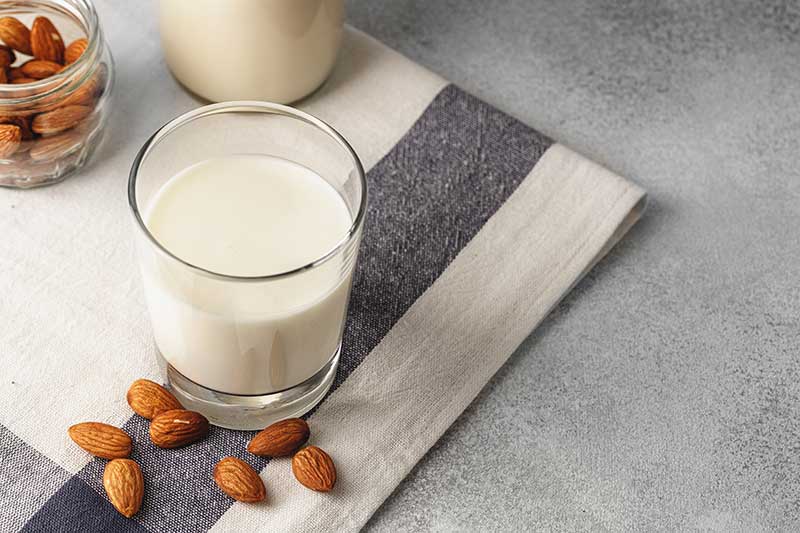
Almond Milk
Almond milk is made by blending almonds with water and then straining the mixture to remove the solids. This process creates a smooth, slightly nutty-flavored milk alternative that can be enjoyed on its own, added to coffee or tea, used in smoothies, or incorporated into various recipes.
Almond milk is creamy and a tad sweet. You can adjust the creaminess by adding more or less water.
Nutrition: Almond milk offers a range of nutritional benefits while being lower in calories, carbs, and saturated fat compared to cow’s milk. Store-bought almond milk is often fortified with vitamins and minerals such as calcium, vitamin D, and vitamin E.
How to Make Almond Milk
Here’s what you need to make homemade almond milk:
- 1 cup raw almonds
- 4 cups filtered water (use more water to make it less creamy)
- Pinch of sea salt
- Optional: Sweeteners such as dates, honey, maple syrup, and/or vanilla extract
Instructions:
- Soak the almonds: Place the almonds in a bowl and cover them with water. Allow them to soak overnight or for at least 6-8 hours. Soaking helps soften the almonds, make them easier to digest, and improves the milk’s texture.
- Rinse and blend: Drain and rinse the soaked almonds. Transfer them to a blender, add 4 cups of filtered water, and blend until smooth and creamy. You may need to do this in batches depending on your blender’s capacity.
- Strain the mixture: Place a nut milk bag or fine cheesecloth over a large bowl or pitcher. Pour the blended almond mixture into the bag or cloth, and gently squeeze or press to extract the milk while separating it from the almond pulp.
- Optional sweetening: If desired, add sweeteners such as dates, honey, or maple syrup to the strained almond milk. Blend again for a few seconds to incorporate the sweeteners evenly.
- Store and enjoy: Pour the freshly made almond milk into a clean jar or bottle, and refrigerate. It will stay fresh for up to 5-7 days. Shake well before serving.

Cashew Milk
You can make cashew milk using soaked raw cashews and water. Cashew milk has gained popularity due to its creamy texture, mild taste, and nutritional benefits. It’s one of the more creamy nut milks, and since cashews don’t have skins, it’s much easier to clean up when making it from scratch.
When you want to make a dairy-based cream sauce, like alfredo, cashew milk makes a wonderful substitute. I find it more creamy and mild than almond milk. It’s important to note though, if you have an autoimmune disease like psoriasis, you might have reactions to cashews.
Nutrition: Cashew milk is known for its nutritional profile. It is low in calories compared to dairy milk and contains healthy fats, fiber, protein, vitamins, and minerals.
How to Make Cashew Milk
Cashew milk is easy to make and takes just two ingredients, like most nut milks. Learn how to make cashew milk with this easy recipe.
Pistachio Milk
Pistachio milk is a dairy-free, plant-based milk that is made from blending or soaking shelled pistachios with water. The resulting liquid is then strained to remove any solid particles, resulting in a smooth, creamy milk alternative.
This plant-based milk has a pale green color and a rich, nutty flavor. The taste of pistachio really comes through in this dairy-free milk.
Nutrition: Pistachios are a good source of monounsaturated and polyunsaturated fats, including omega-3 and omega-6 fatty acids. These healthy fats can promote heart health and help reduce cholesterol levels. Pistachios are rich in essential vitamins and minerals, including vitamin E, potassium, magnesium, and B-vitamins.
Like pistachios themselves, pistachio milk contains antioxidants that can help protect the body from oxidative stress and reduce inflammation.
How to Make Pistachio Milk
Making pistachio milk is super easy! Just follow the instructions below.
Ingredients:
- 1 cup shelled pistachios
- 4 cups filtered water
- Optional: sweeteners (such as maple syrup or dates) or flavorings (such as vanilla extract or cocoa powder)
Instructions:
- Soak the shelled pistachios in water overnight or for at least 4 hours. This helps soften them and makes blending easier.
- Drain and rinse the soaked pistachios.
- Place the soaked pistachios and filtered water in a blender.
- Blend on high speed until the mixture becomes smooth and creamy, typically 1-2 minutes.
- Optional: Add sweeteners or flavorings to suit your taste preferences, and blend for an additional 15-30 seconds.
- Strain the mixture using a nut milk bag or cheesecloth to remove any remaining solids. Squeeze the bag or cloth firmly to extract as much milk as possible.
- Transfer the pistachio milk to a sealed container and store it in the refrigerator. It can be consumed within 3-4 days.
Hazelnut Milk
Hazelnut milk is a type of plant-based milk made from ground hazelnuts and water. Its smooth and velvety texture, coupled with a subtly sweet yet nutty flavor, make it a popular alternative to dairy milk.
The rich, creamy texture of hazelnut milk imparts a deliciously-nutty flavor.
Nutrition: Hazelnuts are rich in heart-healthy monounsaturated fats, similar to those found in olive oil. They are a good source of vitamin E and also contain calcium, magnesium, and phosphorus.
How to Make Hazelnut Milk
Follow these instructions to make your own cashew milk from home.
- 1.5 cup raw hazelnuts
- 4 cups filtered water
- Optional: sweetener (such as maple syrup or dates)
Instructions:
- Soak the hazelnuts in water overnight or for at least 8 hours. This step helps soften the nuts and aids in better blending.
- Drain and rinse the soaked hazelnuts thoroughly.
- Combine the soaked hazelnuts and filtered water in a blender. Blend on high speed until smooth and creamy. If desired, add sweetener to taste and blend again.
- Strain the mixture through a nut milk bag or cheesecloth into a bowl or pitcher, squeezing out as much liquid as possible. This step helps remove any remaining solids, resulting in a smoother consistency.
- Pour the freshly made hazelnut milk into a glass jar or bottle and refrigerate. It can be consumed for up to 4-5 days.
Walnut Milk
Walnut milk is a plant-based milk made from blending walnuts and water together. It offers a creamy texture and a subtly earthy flavor, which makes it a versatile ingredient in various recipes.
Walnut milk tastes more like nuts than almond milk. It’s has a creamy, buttery, and earthy taste.
Nutrition: Walnuts are packed with heart-healthy omega-3 fatty acids and contain antioxidants such as vitamin E and polyphenols. In addition, walnut milk is a source of important minerals like magnesium, phosphorus, and copper
How to Make Walnut Milk
Walnut milk is tasty and creamy and lends itself well as a dairy milk substitute. You can make it from home using raw walnuts and filtered water.
Ingredients:
- 1 cup raw walnuts
- 4 cups filtered water
- Optional: sweetener of your choice (e.g., maple syrup, dates, or honey)
Instructions:
- Soak the walnuts in water overnight or for at least 4 hours. This softens them and helps in achieving a creamier consistency.
- Drain and rinse the soaked walnuts thoroughly.
- Place the walnuts in a blender along with 4 cups of filtered water. If desired, add a natural sweetener for taste.
- Blend on high speed for about 1-2 minutes until the mixture appears smooth and uniform.
- Strain the blended mixture through a nut milk bag or a fine mesh strainer to separate the solids from the liquid.
- Squeeze the bag or press down on the strainer to extract as much liquid as possible.
- Pour the freshly made walnut milk into a glass container or bottle and refrigerate for up to 5 days.
Macadamia Nut Milk
Macadamia nut milk is a dairy-free, vegan-friendly milk alternative made by blending soaked macadamia nuts with water and straining the mixture. The resulting liquid has a smooth consistency, resembling regular milk but with a distinct, nutty taste.
This plant-based milk has a slight vanilla taste to it. It’s also thick, creamy, and has a hint of sweetness.
Nutrition: Macadamia nut milk is low in carbohydrates and does not contain lactose or cholesterol. It also contains a good amount of healthy fats, including monounsaturated fats and is a great source of essential minerals like magnesium and phosphorus.
How to Make Macadamia Nut Milk
Creamy, fresh macadamia milk tastes great in chicory coffee, mushroom coffee, or any other drink or dish you’d normally use cow’s milk. It’s easy to make, just follow the instructions below.
Ingredients:
- 1 cup raw macadamia nuts
- 4 cups filtered water (plus more for soaking)
- Optional sweeteners: dates, maple syrup, or honey (to taste)
- Pinch of sea salt (optional)
Instructions:
- Start by soaking the macadamia nuts in water for at least 4 hours or overnight. This process softens the nuts and aids in achieving a smoother milk consistency.
- Drain and rinse the soaked macadamia nuts thoroughly before adding them to a blender.
- Add 4 cups of filtered water to the blender with the macadamia nuts.
- Blend on high speed until the mixture becomes creamy and the nuts are finely ground.
- Strain the mixture using a nut milk bag or cheesecloth to remove any remaining nut particles, resulting in a smooth milk consistency.
- If desired, add sweeteners like dates, maple syrup, or honey according to your taste preferences. You can also add a pinch of sea salt to enhance the flavor.
- Blend again briefly to incorporate the sweeteners and salt.
- Store the macadamia nut milk in a sealed container in the refrigerator. It can be consumed within 3-4 days.
Coconut Milk
This creamy, milky liquid is derived from the flesh of mature coconuts. Coconut milk has a distinct flavor and is commonly used in both sweet and savory dishes.
This dairy-free milk is slightly seet, thick, and has a tiny-bit of saltiness to it.
Nutrition: Nutritionally, coconut milk is known for its high content of healthy fats. These fats are mainly in the form of medium-chain triglycerides (MCTs), which are believed to have various health benefits.
Additionally, coconut milk is also rich in vitamins and minerals such as iron, magnesium, and potassium.
How to Make Coconut Milk
You can find coconut milk at the store in BPA-free cans without added ingredients or you can make yor own using shredded or grated coconut. Just follow the instructions below.
Ingredients:
- 2 cups of shredded or grated coconut
- 4 cups of water
Instructions:
- Place the shredded coconut and water in a blender or food processor.
- Blend the mixture on high speed for about 2 minutes, until it becomes smooth and creamy.
- Strain the mixture through a cheesecloth or a fine-mesh sieve into a bowl, squeezing out as much liquid as possible.
- Store the coconut milk in a glass jar or airtight container in the refrigerator. It can be kept for about 3-4 days.
Always remember to shake the coconut milk before using it, as it tends to separate when refrigerated. Homemade coconut milk may have a slightly different consistency compared to store-bought versions, but the flavor and nutritional benefits remain intact.
Other Nut-based Milks
- Brazil nut milk
- pecan milk
Plant Based Milk: Seeds
Just like nuts, you can make vegan milk using seeds. You’ll always want to choose raw, organic, unsalted seeds when you make it yourself using the recipes below.
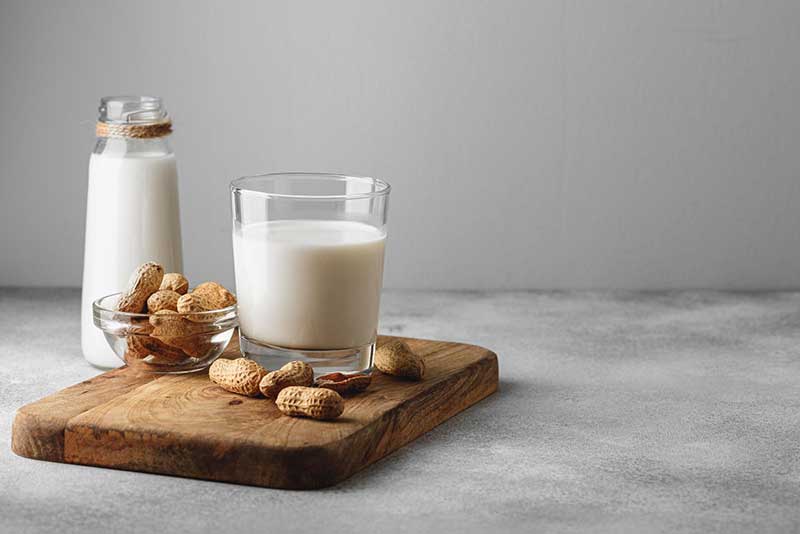
Peanut Milk
Peanut milk, also known as groundnut milk, is a plant-based beverage made from blended peanuts and water. It’s a creamy and delicious milk with a distinct peanut flavor. It’s a great plant milk to use in smoothies.
Nutrition: In terms of nutrition, homemade peanut milk can be a valuable addition to a healthy diet. Peanuts are a rich source of essential nutrients, including protein, healthy fats, and fiber. They also provide important minerals such as magnesium, phosphorus, and potassium. Furthermore, peanuts contain various vitamins, including vitamin E, niacin, and folate.
How to Make Homemade Peanut Milk
You can make peanut milk with raw peanuts or unsalted, dry-roasted nuts. It’s easy to make, like all other plan-based milks.
Ingredients:
- 1 cup raw peanuts (organic and unsalted)
- 3 cups filtered water
- Optional: sweeteners such as honey, maple syrup, or dates to taste
Note: You can also use unsalted dry roasted peanuts if you prefer them over raw nuts.
Instructions:
- Soak the peanuts in water for at least 4 hours or overnight. This helps soften them and improve their digestibility.
- Drain and rinse the soaked peanuts thoroughly.
- Place the soaked peanuts and filtered water in a blender. Blend on high speed until smooth and creamy.
- If desired, sweeten the milk with honey, maple syrup, or dates to taste. Start with a small amount and adjust according to your preference.
- Strain the mixture through a nut milk bag or a cheesecloth-lined sieve to remove any remaining solids. Squeeze the bag or press gently on the solids to extract as much milk as possible.
- Transfer the strained peanut milk into a glass jar or bottle and refrigerate. Homemade peanut milk can be stored in the refrigerator for up to 4-5 days.
Hemp Milk
Hemp milk is made by blending water and hemp seeds together, resulting in a creamy liquid with a slightly nutty flavor.
Unlike its controversial counterpart, hemp milk contains only trace amounts of tetrahydrocannabinol (THC), the psychoactive compound found in marijuana. Therefore, it does not have any psychoactive effects.
Hemp milk is not as creamy as some of the other milk alternatives, although more so than 2% cow’s milk. It has an earthy taste and a slight nuttiness to it.
Nutrition: Hemp milk is an excellent source of plant-based protein, containing all essential amino acids required by the body.
It provides a good balance of omega-3 and omega-6 fatty acids, contains various vitamins, and is a rich source of minerals like calcium, iron, phosphorus, magnesium, and potassium.
How to Make Hemp Milk
This hemp milk recipe will give you results that are a bit thicker than 2% milk.
Ingredients:
- 1 cup of shelled hemp seeds
- 4 cups of filtered water
- Optional: sweeteners (e.g., dates, maple syrup, honey) or flavorings (e.g., vanilla extract, cinnamon) to taste
Instructions:
- In a blender, combine the hemp seeds and filtered water.
- Blend on high speed for about one minute or until the mixture appears smooth and creamy.
- If desired, add sweeteners or flavorings to taste and blend for a few seconds more.
- Using a fine-mesh strainer or nut milk bag, strain the mixture to remove any remaining solids.
- Transfer the milk to a sealed container or bottle, and refrigerate. It can be stored for up to five days.
Sunflower Seed Milk
Sunflower seed milk is made by blending soaked sunflower seeds with water and straining the mixture to create a smooth, creamy beverage. It has a mild, nutty flavor.
Nutrition: Sunflower seed milk is a rich source of vitamin E, which acts as a powerful antioxidant and supports healthy skin and immune function. Additionally, it contains essential minerals such as magnesium, phosphorus, and potassium.
How to Make Sunflower Seed Milk
Ingredients:
- 1 cup of raw, unsalted sunflower seeds
- 3.5 cups of filtered water
- Optional: sweeteners or flavorings (such as dates, vanilla extract, or maple syrup)
Instructions:
- Soak the sunflower seeds in water for at least 4-6 hours or overnight. This softens the seeds and makes them easier to blend.
- Drain and rinse the soaked seeds thoroughly.
- In a blender, combine the soaked sunflower seeds and 4 cups of filtered water. Blend on high speed until the mixture becomes smooth and creamy.
- If desired, add sweeteners or flavorings to taste. This step is optional and depends on personal preference.
- Place a nut milk bag or cheesecloth over a large bowl or pitcher. Pour the blended mixture into the bag or cloth, and gently squeeze to strain out the liquid. This will separate the milk from any remaining pulp.
- Transfer the strained sunflower seed milk to a clean glass jar or bottle, and refrigerate. It can be stored for up to 4-5 days.
Sesame Seed Milk
Also known as tahini milk or sesame milk, seasame seed milk is a dairy-free alternative to traditional cow’s milk. It’s made with sesame seeds and filtered water.
Sesame seed milk has a distinct sesame flavor, although overall it’s pretty neutral in terms of sweet or savory. It has more of a nutty flavor than a “seed” flavor.
Nutrition: Sesame seeds are packed with heart-healthy monounsaturated and polyunsaturated fats and are considered a valuable plant-based protein source.
Sesame seeds also provide a good amount of dietary fiber and are abundant in several essential vitamins and minerals, including calcium, iron, magnesium, zinc, and vitamin E.
How to Make Sesame Seed Milk
I prefer to sweeten sesame seed milk using Medjool dates that have been pitted and soaked.
Ingredients:
- 1 cup sesame seeds
- 4 cups filtered water
- Optional: sweeteners like honey, dates, or maple syrup
Instructions:
- Soak the sesame seeds in water for at least 4 hours or overnight.
- Drain and rinse the soaked seeds thoroughly.
- Place the sesame seeds and filtered water in a high-powered blender.
- Blend on high speed for 2-3 minutes until smooth and creamy.
- If desired, add sweeteners like honey, dates, or maple syrup to taste.
- Strain the mixture through a cheesecloth or nut milk bag, discarding any solids.
- Pour the strained sesame seed milk into a clean container and refrigerate.
- Stir well before use, as natural separation may occur.
- Enjoy your homemade sesame seed milk within 3-4 days.
Flaxseed Milk
Flaxseed milk is made by blending flaxseeds with water and straining the mixture to create a smooth, creamy liquid.
This vegan milk has a mild, nutty flavor that is slightly earthy. It is often described as being creamy and smooth in texture, with a subtle hint of sweetness.
Nutrition: Nutritionally, flaxseed milk is a powerhouse. It is low in calories and contains no cholesterol or saturated fats, making it heart-healthy. Flaxseeds are rich in essential omega-3 fatty acids and are also an excellent source of dietary fiber, aiding in digestion and promoting feelings of fullness.
How to Make Flaxseed Milk
To make flaxseed milk at home, follow this simple recipe:
Ingredients:
- 1 cup of flaxseeds
- 4 cups of filtered water
Instructions:
- Rinse the flaxseeds thoroughly under running water to remove any dirt or impurities.
- Place the rinsed flaxseeds in a bowl and add the filtered water. Let them soak for about 4 hours or overnight in the refrigerator.
- After soaking, transfer the flaxseeds and water mixture to a blender. Blend on high speed for 1-2 minutes until the mixture becomes thick and creamy.
- Strain the mixture through a nut milk bag or cheesecloth into a clean container, ensuring all the liquid is extracted.
- You can gently squeeze the bag or cloth to get the most milk out. The strained liquid is your homemade flaxseed milk.
- Store the flaxseed milk in an airtight container in the refrigerator for up to 5 days. Shake well before each use.
Pumpkin Seed Milk
Pumpkin seed milk is a plant-based milk made by blending soaked pumpkin seeds with water and straining the mixture to remove any solids. It serves as an excellent alternative to cow’s milk for those who are lactose intolerant, have dairy allergies, or follow a vegan or plant-based diet.
Its taste is reminiscent of roasted pumpkin seeds but with a smoother and creamier texture. Pumpkin seed milk has a mild and nutty flavor with a subtle earthy undertone.
Nutrition: Pumpkin seed milk contains a substantial amount of plant-based protein. It’s also rich in unsaturated fats, including omega-6 and omega-9 fatty acids, promotes heart health and aids in reducing inflammation in the body.
Pumpkin seed milk is a good source of essential minerals such as magnesium, potassium, phosphorus, and zinc and contain antioxidants like vitamin E and phenolic compounds.
How to Make Pumpkin Seed Milk
Now, let’s get down to making your very own batch of pumpkin seed milk. Follow these simple steps:
Ingredients:
- 1 cup raw pumpkin seeds
- 4 cups filtered water
- Optional: sweeteners such as dates, honey, or maple syrup for taste
Instructions:
- Soak the pumpkin seeds: Place the pumpkin seeds in a bowl and cover them with water. Allow them to soak for at least 4 hours or overnight. Soaking helps in removing enzyme inhibitors and increasing digestibility.
- Drain and rinse: Drain the soaked pumpkin seeds and rinse them thoroughly under running water to remove any residue.
- Blend: Transfer the soaked pumpkin seeds to a blender and add 4 cups of filtered water. Blend on high speed for 1-2 minutes until the mixture becomes smooth and creamy.
- Strain: Place a nut milk bag or a fine-mesh sieve over a large bowl. Pour the blended mixture slowly into the bag or sieve, allowing the liquid to strain while separating any solids.
- Sweeten if desired: Taste the milk and, if desired, add a natural sweetener like dates, honey, or maple syrup. Blend again for a few seconds to incorporate the sweetener.
- Store and enjoy: Transfer the strained milk to a sealed container and refrigerate. It can be stored for up to 4-5 days. Remember to shake well before using, as separation may occur.
Other Seed-based Milks
- buckwheat
- poppy seed
Plant Based Milk: Fruit & Vegetables
While you can enjoy plant based milks made from nuts, seeds, and grains (see below for that list), did you know you can also make milk based from plants using fruits, vegetables, and tubers?
Potato Milk
Potato milk is a plant-based milk substitute made by blending or straining cooked potatoes with water. Of course, potatoes are a nightshade food, so if you cannot eat nightshades, don’t use potato milk.
Potato milk has a mild, slightly sweet flavor with a creamy and silky texture. Some compare its taste to that of almond milk, but with a subtler taste and creamier mouthfeel. The flavor of potato milk allows it to be seamlessly incorporated into both sweet and savory recipes.
Nutrition: Potato milk is rich in essential vitamins and minerals such as vitamin C, vitamin B6, potassium, and magnesium. Compared to dairy milk, potato milk is lower in calories and it’s also cholesterol-free.
How to Make Potato Milk
Making potato milk is easy, but it does have an extra step since you need to cook the potatoes. first You could try this using white sweet potatoes for a slightly sweeter potato milk.
Ingredients:
- 2-3 medium-sized potatoes
- 4 cups of water
Instructions:
- Peel the potatoes and cut them into small cubes.
- In a pot, bring the water to a boil and add the potato cubes.
- Cook the potatoes until they are tender and easily break apart with a fork. This usually takes around 15-20 minutes.
- Once cooked, drain the potatoes and transfer them to a blender or food processor.
- Start by adding 3 cups of water to the blender and blend until smooth and creamy. If needed, add more water to achieve the desired consistency.
- Pour the blended mixture through a fine-mesh strainer or cheesecloth to remove any remaining potato solids. This step is optional if you prefer a slightly thicker texture.
- Transfer the potato milk to a clean container and refrigerate. It can be stored for up to 4-5 days.
Note: potato milk can be combined with a nut milk, such as almond milk to enhance thae flavor.
Banana Milk
Banana milk is made by blending ripe bananas with water, creating a creamy and naturally sweet “milk.”
Nutrition: It’s rich in essential vitamins and minerals. A typical serving contains around 110-130 calories. It is also low in fat and cholesterol-free, making it an excellent choice for individuals with dietary restrictions.
Additionally, Banana Milk is an abundant source of potassium, an essential mineral for maintaining proper heart and muscle function. It also contains vital nutrients such as vitamin C, vitamin B6, and dietary fiber, which contribute to overall well-being.
How to Make Banana Milk
Let’s explore a simple recipe for making banana milk at home:
Ingredients:
- 2 ripe bananas
- 2 cups of water
Instructions:
- Peel the bananas and add them to a blender.
- Pour in the water and blend on high speed until smooth and creamy.
- If desired, add a sweetener of your choice to enhance the taste. Start with a small amount and adjust according to your preference.
- Blend again for a few seconds to incorporate the sweetener.
- Pour the mixture into a glass jar or pitcher and refrigerate for at least 1 hour to chill.
- Give it a good stir before serving. You can also add a dash of cinnamon or a sprinkle of nutmeg for an extra flavor boost.
Tigernut Milk
Tigernut milk, also known as horchata de chufa, is made from the tuberous root vegetable known as tigernut. Despite its name, tigernuts are not actually nuts but rather small edible tubers that grow underground. These tubers are rich in nutrients and have a slightly sweet and nutty flavor, which makes them a perfect ingredient for making milk.
Tigernut milk offers a unique taste that is both naturally sweet and slightly nutty. It has a creamy and smooth texture that many people compare in taste to almond milk or coconut milk, although it has its own distinct flavor profile.
Nutrition: Tigernut milk is an excellent source of dietary fiber and contains healthy fats, such as monounsaturated fats and omega-6 fatty acids. It’s also packed with essential vitamins and minerals, including vitamin E, vitamin C, magnesium, potassium, and phosphorus.
How to Make Tigernut Milk
Making your own tigernut milk at home is surprisingly simple. Here’s a quick and easy recipe to get you started:
Ingredients:
- 1 cup of tigernuts
- 4 cups of filtered water
- Optional: sweeteners like dates, honey, or maple syrup for added sweetness
Instructions:
- Soak the tigernuts in water overnight or for at least 8 hours to soften them.
- Drain and rinse the soaked tigernuts.
- Place the tigernuts in a blender with 4 cups of filtered water.
- Blend on high speed for about 1-2 minutes until the mixture becomes smooth and creamy.
- If desired, add sweeteners to taste and blend again briefly.
- Strain the mixture through a nut milk bag or cheesecloth to remove any remaining solids.
- Transfer the strained milk into a clean container and refrigerate.
- Tigernut milk can be stored for up to 4-5 days in the refrigerator.
Plant Based Milk: Grains
You can use grain-based milk in place of dairy milk for most recipes. These plant based milk options are good for those who choose to consume pseudo grains or regular grains.
Oat Milk
Oat milk is made from oats, water, and sometimes additional ingredients like sweeteners or flavorings. It offers a creamy texture similar to cow’s milk, making it a versatile option for various uses.
Nutrition: Rich in fiber, oat milk aids digestion and helps you feel fuller for longer. Oat milk is also fortified with essential vitamins and minerals such as calcium, vitamin D, and vitamin B12, ensuring you maintain a balanced diet.
How to Make Oat Milk
Learn how to make your own oat milk with this easy recipe. Here’s what you will need:
- 1 cup rolled oats
- 4 cups water
- 1-2 tablespoons sweetener (optional)
- 1 teaspoon vanilla extract (optional)
- Pinch of salt
Instructions:
- Start by soaking the rolled oats in water for 30 minutes. This step helps soften the oats and enhances the creaminess of the milk.
- After soaking, drain and rinse the oats thoroughly.
- Place the soaked oats, water, sweetener (if desired), vanilla extract (if desired), and a pinch of salt into a blender.
- Blend on high speed until the mixture becomes smooth and frothy, usually around 1-2 minutes.
- Using a fine-mesh strainer or cheesecloth, strain the mixture into a clean container, separating the liquid (your homemade oat milk) from the oat pulp.
- Transfer the milk to a sealable bottle or jar and refrigerate. It can be stored for up to five days.
Rice Milk
Rice milk is a plant-based milk alternative made by blending milled rice with water. Typically, brown or white rice is used in the process. The mixture is strained to remove any solid particles, resulting in a smooth, creamy beverage.
Rice milk is naturally sweet and has a mild flavor, making it a versatile choice for various applications.
Rice Milk Nutrition: Rice milk is typically low in fat, making it a great option for those aiming to reduce their saturated fat intake. However, it is important to note that rice milk generally contains less protein than cow’s milk.
It’s naturally cholesterol-free and is often fortified with essential vitamins and minerals, such as calcium, vitamin D, and vitamin B12.
How to Make Rice Milk
If you’d like to make your own rice milk at home, here’s a simple recipe to get you started:
- 1 cup of organic, high-quality cooked rice (white or brown)
- 4 cups of filtered water
- 1-2 tablespoons of sweetener (optional), such as honey or maple syrup
- 1 teaspoon of vanilla extract (optional)
Instructions:
- Rinse the cooked rice thoroughly to remove any excess starch.
- In a blender, combine the rinsed rice and filtered water.
- Blend on high speed for about 2 minutes or until the mixture becomes smooth and creamy.
- If desired, add sweetener and vanilla extract, then blend for an additional 30 seconds.
- Using a fine-mesh strainer or cheesecloth, strain the mixture to remove any remaining solids.
- Transfer the rice milk to a clean container and refrigerate for at least 2 hours before serving.
- Stir well before use, as separation may occur.
Other grain-based milks:
- rye milk
- barley milk
- wheat milk
- spelt milk
- millet milk
- sorghum milk
- teff milk
- aramanth milk
- quinoa milk
Plant Based Milk: Legumes
This type of milk is gaining popularity among individuals who follow a vegetarian, vegan, or plant-based diet, as well as those who are lactose intolerant or have allergies to cow’s milk.
Soy Milk
Soy milk is a non-dairy milk substitute made from soybeans. It is produced through a process of soaking, grinding, boiling, and straining soybeans. The resulting liquid has a creamy, slightly nutty taste.
Nutrition: Soy milk is a fantastic source of complete protein, making it an excellent choice for those following a plant-based diet or looking to reduce their intake of animal products. With approximately 8 grams of protein per cup, it’s a great way to meet your daily protein needs.
Furthermore, soy milk is low in saturated fat and cholesterol-free, making it a heart-healthy option. It is also naturally lactose-free, making it suitable for individuals with lactose intolerance or dairy allergies.
How to Make Soy Milk
- 1 cup of dried soybeans
- 4 cups of water
- Sweetener of your choice (optional)
Instructions:
- Soak the soybeans in water overnight or for at least 8 hours. This will help soften them and make blending easier.
- Drain and rinse the soybeans thoroughly, removing any impurities.
- In a blender, combine the soaked soybeans and 4 cups of fresh water. Blend on high speed until smooth and creamy.
- Strain the mixture using a cheesecloth or a nut milk bag, squeezing out as much liquid as possible.
- If desired, add a natural sweetener like agave syrup or vanilla extract to enhance the flavor. Stir well.
- Transfer the freshly made soy milk to a sterilized container and refrigerate. It can be stored for up to 3-4 days.
Pea Milk
Pea milk, also known as pea protein milk, is a non-dairy alternative made from yellow peas.
Nutrition: Nutritionally, pea milk is a rich source of protein, containing approximately 8 grams of protein per serving. It is also low in saturated fat, making it a heart-healthy choice.
How to Make Pea Milk
- 1 cup dried yellow peas
- 4 cups water
- Sweetener of your choice (optional)
- Pinch of salt (optional)
Instructions:
- Soak the yellow peas in water overnight or for at least 8 hours. This helps soften the peas and aids in the blending process.
- Drain and rinse the soaked peas thoroughly to remove any remaining impurities.
- Place the soaked and rinsed peas into a blender along with 4 cups of fresh water.
- Blend on high speed for 2-3 minutes until you achieve a smooth, creamy consistency.
- To remove any remaining solids, strain the mixture using a nut milk bag or a cheesecloth. Squeeze the bag to extract as much liquid as possible.
- If desired, add a sweetener like maple syrup or a pinch of salt to enhance the flavor. Adjust the amount according to your taste preference.
- Pour the freshly made pea milk into a clean, airtight container and refrigerate. It can typically be stored for up to 5-7 days.
Other Legume-based Milks
- chickpea milk
- cowpea milk
- lupin milk
Plant-Based Milk FAQs
Still have questions about using plant based milk instead of dairy milk? Here are some frequently asked questions about plant-based milk.
What is plant-based milk?
Plant-based milk, also known as non-dairy milk, is a nutritious alternative to traditional dairy milk. Unlike its animal-based counterpart, plant-based milk is made from various plant sources, such as nuts, grains, seeds, and legumes.
This milk alternative has gained popularity due to its health benefits, environmental sustainability, and suitability for individuals with lactose intolerance or dietary restrictions.
Who drinks plant-based milk?
Many people are turning to plant-based milks due to lactose intolerance, allergies, or a desire to reduce their intake of saturated fats or cholesterol. Plant-based milk provides a nutritious and often more easily digestible option compared to dairy milk.
Those who follow vegan and vegetarian diets also substitute plant based milk for dairy milk to avoid consuming animal protein.
Why choose plant-based milk alternatives?
One of the primary reasons people opt for plant-based milk alternatives is because they are lactose-free. Plant-based milk alternatives are an excellent choice for individuals seeking a healthier, lactose-free, and environmentally friendly alternative to dairy milk.
Packed with nutrients, lower in calories, and offering versatile flavors, these alternatives provide a satisfying and enjoyable addition to your healthy lifestyle. By making the switch, you can embrace a more sustainable approach to nutrition while still relishing the pleasure of a delicious and nutritious beverage.
What substitutes are there for dairy milk?
There are many different substitutes for dairy milk. Nut milks, for example, include: almond, cashew, pistachio, hazelnut, walnut, macadamia nut, and coconut milk. Seed and legume milks include peanut, hemp, sunflower, sesame, flaxseed, pumpkin seed, soy milk, and pea milk.
There’s also fruit, vegetable, & tuber milks, such as: potato milk, banana milk, and tigernut milk. Lastly popular grain-based milks include oat milk and rice milk.
Are plant-based milks good for you?
Store-bought plant-based milks are typically fortified with calcium, vitamin D, vitamin B12, and sometimes even protein. These milks are naturally lactose-free, making them easier to digest and reducing the risk of digestive discomfort. Plant-based milks are also cholesterol-free and low in calories.
Plant-based milks vs dairy milk: Are they equally healthy?
Dairy milk is known for its rich content of essential nutrients. It is an excellent source of high-quality protein, calcium, vitamin D, and vitamin B12. Additionally, it contains various nutrients like riboflavin, phosphorus, and potassium, which are vital for maintaining good health.
Plant-based milks come in various forms such as almond, soy, coconut, oat, and rice milk. While they differ in nutritional composition, most plant-based milks are fortified with essential nutrients to mimic the nutritional value of dairy milk. However, they may lack certain nutrients naturally present in dairy milk, such as vitamin B12 and calcium.
Are plant-based milks better for the environment?
Plant-based milks offer several environmental benefits, making them a more sustainable choice compared to dairy milk. With their lower greenhouse gas emissions, reduced water footprint, land use efficiency, and support for sustainable farming practices, plant-based milks align well with the growing concern for the environment.
Does plant-based milk go bad?
Plant-based milk does go bad, although the shelf life may vary depending on the brand and type. Unopened plant-based milk typically has a longer shelf life and can last anywhere from a few weeks to a few months, if stored properly. Once opened, plant-based milk should be refrigerated and consumed within a specified time frame.
Homemade plant-based milk should be refrigerated and consumed within 3-5 days, depending on the type of milk you made.
Should you be concerned about additives in plant-based milk?
It is important to read labels carefully. You want to avoid added oils, sugar, thickeners, and gums.
How can I make my homemade plant-based milk creamier?
To make your homemade dairy-free milk creamier, just decrease the amount of water used to the desired consistency.
What’s the creamiest plant-based milk?
The creamiest plant-based milk made from nuts is cashew milk. The creamiest gran-based milk is oat milk.
Final Summary
With so many choices for plant-based milk, you can easily find one that suits your tastebuds! These delicious, dairy-free milk alternatives are loaded with vitamins and are easy to make at home. When purchasing store-bought dairy-free milk, be sure to read the labels carefully.



